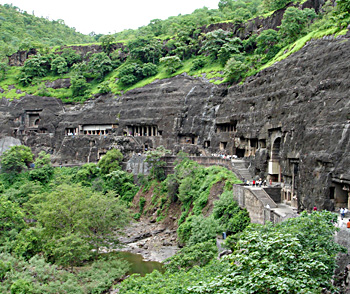 History of Jalgaon district in its early part is rather obscure. It is believed to have been part of a region known as Rasika in the ancient times. Following this, the region came under the rule of the Farqui kings and was henceforth known as Khandesh. The district continued to be known as East Khandesh prior to 21st October, 1960. According to Abul Fazl, the famous historian of the Mughal court, the name Khandesh is derived from the "Khan" title given by Ahmad-I of Gujarat (1411-1443) to Malik Nasir, the second of the Faruki kings. According to some sources, the name comes from the Khandava forest of the Mahabharata. The Mahabharata mentions Yuvanshava, the ruler of Toranmal (Nandurbar district) as fighting with the Pandavas. The rock temples and caves at Nashik and the Ajanta caves show that during the first three centuries AD, Khandesh was under rulers who patronised Buddhism. Thereafter, it was ruled by the Satavahana Kings, Andhrabhrityas, Virsen (Ahir King), Yawan dynasty, Chalukya dynasty, Yadavas and then Ala-ud-din Khilji, Mohammad bin Tughluq, Malik Raja Malik Nazir, the Nizams of Hyderabad, and subsequently the Marathas came to rule the region.
History of Jalgaon district in its early part is rather obscure. It is believed to have been part of a region known as Rasika in the ancient times. Following this, the region came under the rule of the Farqui kings and was henceforth known as Khandesh. The district continued to be known as East Khandesh prior to 21st October, 1960. According to Abul Fazl, the famous historian of the Mughal court, the name Khandesh is derived from the "Khan" title given by Ahmad-I of Gujarat (1411-1443) to Malik Nasir, the second of the Faruki kings. According to some sources, the name comes from the Khandava forest of the Mahabharata. The Mahabharata mentions Yuvanshava, the ruler of Toranmal (Nandurbar district) as fighting with the Pandavas. The rock temples and caves at Nashik and the Ajanta caves show that during the first three centuries AD, Khandesh was under rulers who patronised Buddhism. Thereafter, it was ruled by the Satavahana Kings, Andhrabhrityas, Virsen (Ahir King), Yawan dynasty, Chalukya dynasty, Yadavas and then Ala-ud-din Khilji, Mohammad bin Tughluq, Malik Raja Malik Nazir, the Nizams of Hyderabad, and subsequently the Marathas came to rule the region.
In the 18th century, Khandesh was captured by British troops from the Holkar regime with Dhule as the headquarters. Robert Gill was the first officer of the British East India Company in the Khandesh district with headquarters at Dhule. In 1906 when Khandesh was divided, east Khandesh became present-day Jalgaon. In 1956 with the reorganisation of states, it was included in Bombay state, and with the formation of Maharashtra in 1960, Jalgaon became a district of the state.
The historical legacy of Jalgaon district continues to this day. In the Parola Tahsil, there are remains of a fort believed to have belonged to the father of the great Rani of Jhansi. All India Congress Session of 1936 was held at Faizpur in Yawal Tehsil here in the district of Jalgaon. In present times, the legendary poetess Bahinabai Chaudhari of Jalgaon spread the fame of the Ahirani dialect across the seven seas. Sane Guruji awakened the labour class while Balkavi Thomre`s poetry enriched the socio-cultural life of the district.






